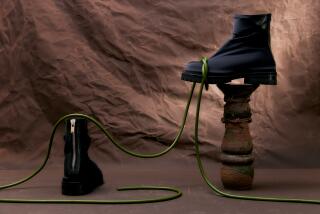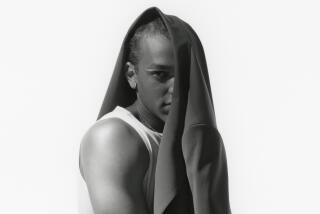Behind the Clothes That Make the Man : In a Fitting Development, Custom Suits Are Accessorized by Tailor-Made Image
- Share via
You won’t find custom tailor Michael Renzi of Newport Beach feeding fabric into a sewing machine, cutting out patterns or performing many of the other tasks commonly expected of a tailor. In fact, Renzi admits he does not know how to sew.
Renzi represents a new generation of tailors who spend little if any time working with needle and thread. Today’s master tailors are more likely to be found schmoozing than sewing.
They’ve become image-makers to the rich and famous, dressing athletes, entertainers and corporate CEOs.
In Renzi’s case, being a tailor means catching a Lear jet to Las Vegas to witness a client’s wedding, vacationing with another client at a swanky ski resort, boating to Catalina for lunch or hurrying off in a helicopter to meet an important executive.
It’s having stars like Milton Berle sing your praises on a national TV show. “I prefer . . . this wonderful tailor to come to me,” Berle told “Extra” on a recent segment regarding custom tailors.
Renzi has put together a personal wardrobe for Kelsey Grammer, star of TV’s “Frazier.” He has made suits for entertainer Steve Allen, comedian Richard Lewis and former Angels catcher Mike Fitzgerald. Talk show hosts, athletes and actors have sought his services.
“They’re usually at the top of what they do, and they treat you with mutual respect,” says Renzi, looking like an executive himself in a lavender shirt with gold cuff links, gray slacks and a coordinating silk tie.
Renzi works not in a traditional cluttered tailor’s shop but in offices befitting a CEO at his headquarters for Renzi Custom Galleries Inc. Across the street at Fashion Island Newport Beach, he has an upscale showroom where clients can order a custom suit or shirt while poring over books of fabric swatches and relaxing on elegant upholstered chairs.
Renzi is convinced that the future is bright for tailors, even though men can go out and buy a mass-produced suit at a department store for less than the cost of a custom suit, which ranges from about $800 to $3,000 at Renzi.
The industrial age forced many neighborhood tailors to leave their workbenches.
Yet those tailors who have modernized their operations while still offering custom, handmade garments have survived and prospered. The reason: While men have a limited selection of suits in a department store, a custom tailor can make a suit according to their exact size, taste and lifestyle.
“[With] department store menswear you might have 10 suits to pick from in your size,” Renzi says.
Custom tailors can offer men an almost unlimited choice of fabrics (Renzi has 10,000 swatches on hand) and the ability to pick their own design.
“They never have to settle for clothes,” Renzi says.
In addition, many men do not conform to the menswear industry’s sizing standards. A custom tailor can make a suit that fits perfectly.
“We do clothing for 7-foot-tall basketball players and 300-pound linebackers,” he says.
Renzi has 14 salespeople, also called tailors, who travel throughout Southern California to clients’ homes and offices. In the case of a very good client, one whose minimum purchase might exceed $10,000, the tailors will go anywhere in the country.
Renzi’s tailors work with the clients in choosing the design of the suit or garment.
Old-time tailors showed their clients hand-drawn sketches of suits, slacks and sport coats. Renzi designs his garments on a computer program, in which he can enter a client’s measurements and obtain a finished pattern. The pattern is sent out to one of four manufacturing shops back East for production, to be stitched by hand or machine on an assembly line.
The only sewing done at Renzi’s showroom is alterations. In the future, Renzi will use the computer to show his clients pictures of themselves as they would look in the suit or sport coat.
“The old master tailor did everything--he cut and sewed, and it took about one week to make a suit,” Renzi says.
His company can turn out about 1,000 custom suits a week. Improved productivity is one reason the tailoring business is growing, increasing its share of the menswear market from 2% to 6% over the past decade, Renzi says.
“This will be the way men buy suits in the future.”
Some aspects of the tailoring business have not changed. The pattern pieces are still cut from the fabric by hand to accurately match patterns and weaves. Bench-made custom suits are still stitched entirely by hand, making them more costly than machine-stitched suits.
“The advantage of hand-sewing is the suit is more flexible. It moves with you. The other is more rigid and board-like,” Renzi says.
Clients can order a complete wardrobe from Renzi, including custom-made jeans that sell for $300. “They are not inexpensive,” Renzi says. “But they fit.”
Fitting a client’s image is just as important as fitting his body, he says.
“The real power of clothing is that it makes you look and feel good.”
Renzi, 40, has been in the tailoring business for 16 years. While attending Idaho State, he worked in sales for a gentlemen’s clothing manufacturer, where he learned about design and custom clothing. He studied under several master tailors and worked as a tailor for Tom James Inc., a men’s custom clothing company based in Texas.
Renzi decided there was a market for higher-end custom clothing, and in 1986 he and a partner opened Renzi (then called Hilton 35) in Lakewood. After his partner retired, he took over the business and moved to Newport Beach in 1993.
Renzi, former president of the Custom Tailors and Designers Assn. of North America, says men need to be better educated about clothing. Most men, he says, know more about buying a new driver for their golf clubs than buying a new suit, even though the suit might cost more than $1,000.
What to look for in a well-made custom suit? Menswear experts offer these tips:
* Arm holes and collars, the stress points of a suit, should be sewn by hand.
* The garment should be light and flexible.
* The lining should be silky.
* Buttons should be high quality; cheap-looking buttons are a sign of cutting corners.
* Beware of fabrics that are too delicate and won’t perform over time.






